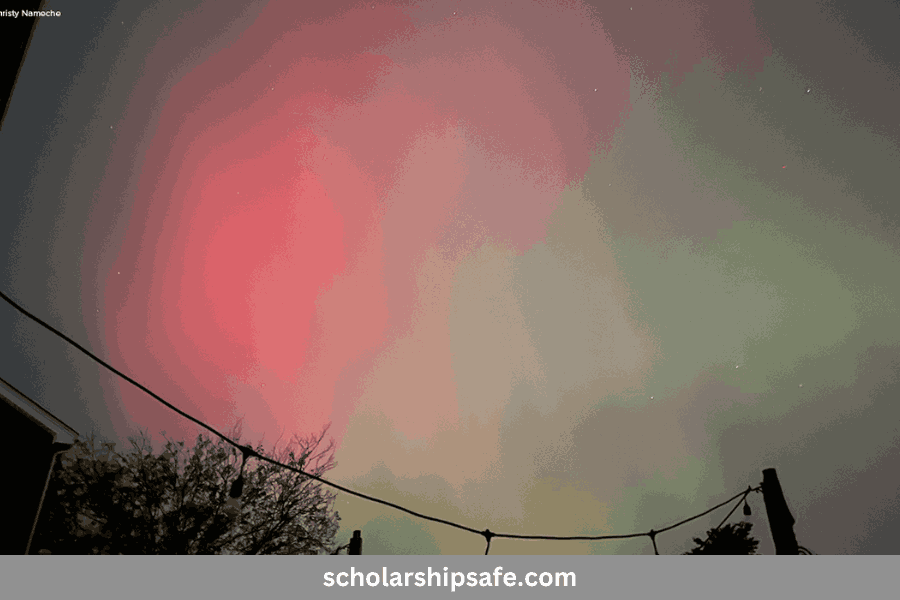For many, the Northern Lights, or Aurora Borealis, are a breathtaking spectacle usually reserved for the northernmost regions of the planet. However, in a rare and thrilling event, the Northern Lights were visible in an unexpected location—Chicago. This enchanting display was due to a severe solar storm, allowing the lights to be seen as far south as the Windy City.
What Are the Northern Lights?
The Northern Lights are natural light displays that occur when charged particles from the sun collide with atoms in Earth’s atmosphere. These particles, carried by solar winds, interact with the Earth’s magnetic field, creating vibrant colors that dance across the night sky. The result is a visual phenomenon marked by waves of green, purple, blue, and sometimes red hues that ripple above, creating an awe-inspiring sight.
Typically, the Northern Lights are best seen in high-latitude areas such as Alaska, Norway, and Canada. But, due to a particularly strong solar storm, also known as a geomagnetic storm, people in more southern latitudes—including Chicago—have the rare chance to witness this celestial display.
Also You Can Check; Hurricane Milton Inundates Florida with Dangerous Flooding After Landfall
Why Were the Northern Lights Visible in Chicago?
The unusual visibility of the Northern Lights in Chicago can be credited to a powerful solar storm, classified as G4 or “severe” on the space weather scale. These storms occur when the sun releases vast amounts of energy, often during a solar flare or coronal mass ejection (CME), sending streams of charged particles hurtling towards Earth.
Once these particles reach Earth’s magnetic field, they energize it, creating a geomagnetic storm that intensifies the Northern Lights, making them visible farther south than usual. Chicagoans were fortunate enough to witness this rare spectacle, which illuminated the skies over the Midwest and beyond.
Best Viewing Conditions
For those lucky enough to catch the Aurora Borealis in Chicago, conditions had to be just right. Here are the factors that contributed to optimal viewing of the Northern Lights during this event:
- Clear Skies: Cloudless or partially clear skies are essential to seeing the Northern Lights. In this instance, clear weather over much of Chicago provided an excellent view.
- Minimal Light Pollution: Urban areas like Chicago tend to have significant light pollution, which can make it difficult to see faint celestial phenomena. However, by venturing to areas with less artificial light, such as the city outskirts or nearby parks, many residents were able to witness the event.
- Dark, Late-Night Viewing: The Northern Lights are most visible late at night when the sky is darkest. Those who stayed up into the early hours of the morning enjoyed the most vibrant displays.
- Timing of the Solar Storm: The visibility of the Northern Lights is linked to the timing of the geomagnetic storm. Space weather predictions gave enthusiasts a window of opportunity to witness the display.
How Often Can Chicago See the Northern Lights?
While it’s uncommon to see the Aurora Borealis in Chicago, it’s not entirely unheard of. During periods of heightened solar activity, particularly when severe solar storms occur, it is possible for the Northern Lights to be visible in lower latitudes.
Solar storms follow an 11-year solar cycle, and we are currently approaching the peak of this cycle, meaning more geomagnetic storms could happen in the coming years. As solar activity increases, the possibility of future Northern Lights sightings in regions like Chicago becomes more likely.
Where to Watch the Northern Lights Near Chicago
If you missed this recent event or want to increase your chances of witnessing the Northern Lights in the future, consider venturing away from the bright lights of the city. Here are a few recommended spots:
- Illinois Beach State Park: Located along the shores of Lake Michigan, this park offers expansive views of the northern horizon, perfect for spotting the Aurora Borealis.
- Indiana Dunes National Park: Just a short drive from Chicago, the dark skies over the Indiana Dunes offer a prime viewing location.
- Starved Rock State Park: This park, about two hours southwest of the city, is far enough from urban light pollution to give you a good chance of spotting the lights on a clear night.
Final Thoughts
The recent appearance of the Northern Lights in Chicago is a reminder of the Earth’s connection to the vast and mysterious forces of space. For many, witnessing the Aurora Borealis is a once-in-a-lifetime experience, especially in an area where it’s so rarely visible. As solar activity continues to increase, Chicagoans may find themselves looking to the skies more frequently, hoping to catch another glimpse of this mesmerizing phenomenon.

